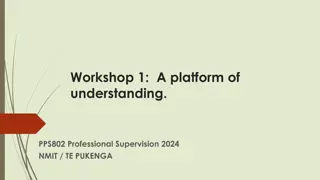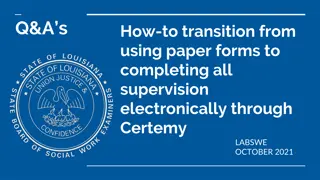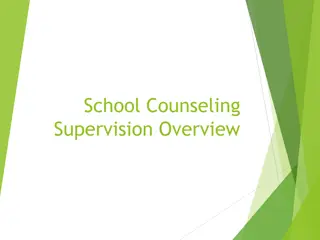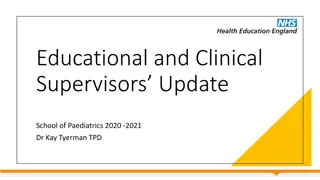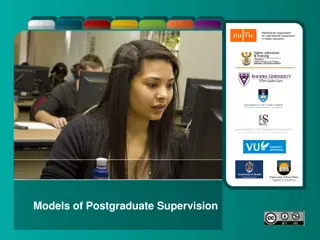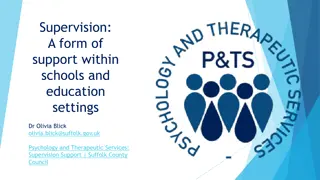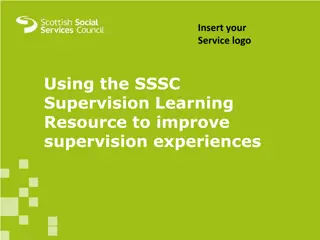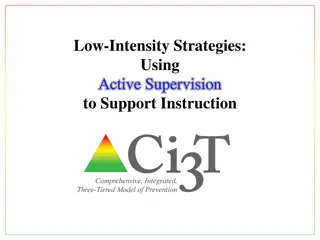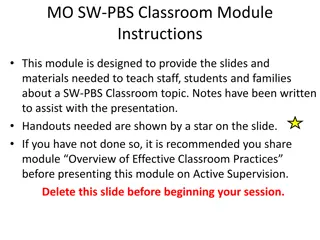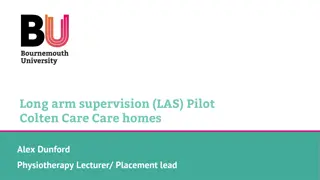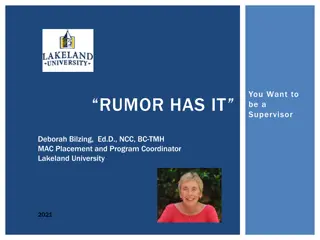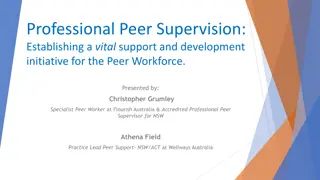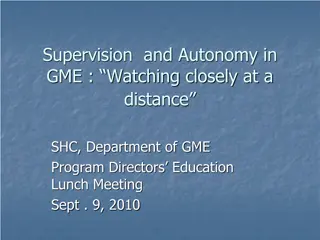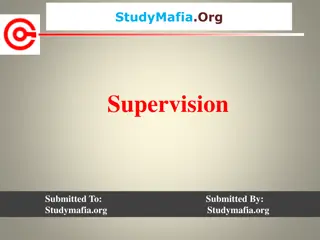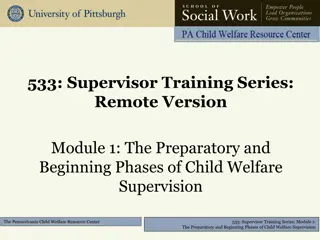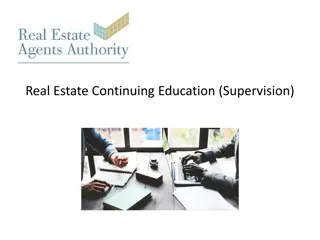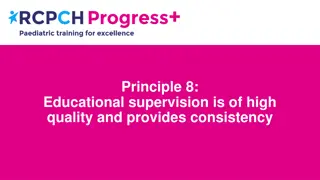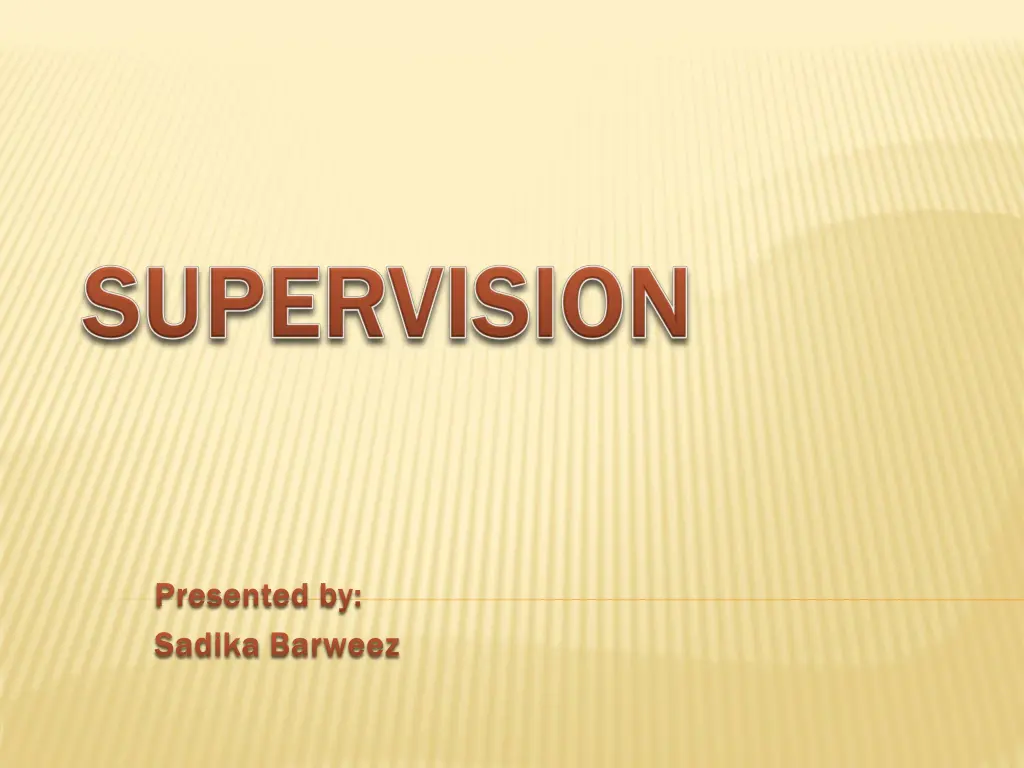
Definitions and Domains of Educational Supervision
Explore the definitions and domains of educational supervision, including the role of designated officials in providing support to educators, facilitating professional growth, and improving instructional practices. Learn about the various domains such as community relations, staff development, and curriculum development, essential for effective supervision in educational settings.
Download Presentation

Please find below an Image/Link to download the presentation.
The content on the website is provided AS IS for your information and personal use only. It may not be sold, licensed, or shared on other websites without obtaining consent from the author. If you encounter any issues during the download, it is possible that the publisher has removed the file from their server.
You are allowed to download the files provided on this website for personal or commercial use, subject to the condition that they are used lawfully. All files are the property of their respective owners.
The content on the website is provided AS IS for your information and personal use only. It may not be sold, licensed, or shared on other websites without obtaining consent from the author.
E N D
Presentation Transcript
Presented by: Presented by: Sadika Sadika Barweez Barweez
Supervision Supervision Definitions: A dictionary of Education defines Supervision as : Fill in the gaps with words given below : Fill in the gaps with words given below : " all efforts of designated officials towards providing ? to ? workers in the ? involves the simulation of and ? of teachers, the and revision of educational ? ,materials of ? and methods of ? the ? of instruction ." leadership educational teachers improvementprofessional and other ? of instruction; ? selection growth development objectives instruction ? teaching evaluation evaluation /instruction /educational/improvement evaluation /instruction /educational/improvement professional growth / leadership /selection professional growth / leadership /selection teaching / development / teachers/ objectives teaching / development / teachers/ objectives ; and
Supervision Supervision Definitions: Supervision is a planned programme for the improvement of instruction ( Adams And Dicky ) Kimball Wills defines supervision as " an assistance in the development of teaching learning situation Burton and Bruectner have described it as : "an expert technical service primarily aimed at studying and improving co-operatively all factors which affect child growth and development.'
Domains of Supervision Match the domains given in the following table to their definitions : Match the domains given in the following table to their definitions : No. Domain Definition 1Community Relations 2Staff Development 3Planning and Change 4Communication Establishing and maintaining open and productive relations between the school and its community. Developing and facilitating meaningful opportunities for professional growth. Initiating and implementing collaboratively developed strategies for continuous improvement. Ensuring open and clear communication among individuals and groups through the organization. Coordinating and integrating the process of curriculum development and implementation. Supporting and coordinating efforts to improve the instructional program. 5Curriculum 6Instructional Program
No. No. Domain Domain Definition Definition 7Service to Teachers Providing materials, resources, and assistance to support teaching and learning. 8Observation and Conferencing Providing feedback to teachers based on classroom observation. 9Problem Solving and Decision Making 10Research and Program Evaluation 11Motivating and Organizing Using a variety of strategies to clarify and analyze problems and to make decisions. Encouraging experimentation and assessing outcomes. Helping people to develop a shared vision and achieve collective aims. Recognizing and reflecting upon one s personal and professional beliefs, abilities, and action. 12Personal Development
The main roles of a supervisor The main roles of a supervisor Keep the descriptions below in their correct columns : Keep the descriptions below in their correct columns : Coordinator Consultant Group Leader Evaluator -assists groups in consensus building, in moving toward group goals, and in perfecting the democratic process -helps teachers find answers to curricular and instructional problems -acts as a link between programs and people. -renders service to both individual teachers and groups. - seeks, identifies, and fosters leadership from within the group. -should be a prime source of assistance to teachers wishing to improve either their generic or specialized teaching skills -knows the disparate pieces of the educational process and directs the actions of others to make the pieces blend. -helps teachers evaluate their classroom performance.
The main roles of a supervisor The main roles of a supervisor Coordinator Coordinator serves as a coordinator of programs, groups, materials, and reports/ acts as a link between programs and people/ knows the disparate pieces of the educational process and directs the actions of others to make the pieces blend/ plans, arranges, evaluates /often conducts in-service programs with and for teachers. renders service to both individual teachers and groups /may simply furnish necessary information and suggestions/ may help teachers define, set, and pursue goals/should be a prime source of assistance to teachers wishing to improve either their generic or specialized teaching skills. releases the potential of groups seeking to improve the curriculum, instruction, or themselves / assists groups in consensus building, in moving toward group goals, and in perfecting the democratic process /seeks, identifies, and fosters leadership from within the group. provides assistance to teachers in evaluating instruction and curriculum/ helps teachers find answers to curricular and instructional problems/ helps teachers evaluate their classroom performance, assess their own strengths and weaknesses, and select means of overcoming their deficiencies. Consultant Consultant Group Group Leader Leader Evaluator Evaluator
CATEGORIES OF SUPERVISORY BEHAVIORS CATEGORIES OF SUPERVISORY BEHAVIORS Listening Listening Clarifying Clarifying Encouraging Encouraging Reflecting Reflecting Presenting Presenting Problem Solving Problem Solving Negotiating Negotiating Directing Directing Standardizing Standardizing Reinforcing Reinforcing
Session 6: 21 slides CONTINUUM OF PURPOSEFUL BEHAVIORS When the Supervisor is... Supervisory styles Directive Informational Nondirective Collaborative Listening Clarifying Encouraging Reflecting Presenting Problem Solving Negotiating Directing Standardizing Reinforcing Directive Control ...then the interpersonal dynamic is evidencing... High Teacher Responsibility Low Teacher Responsibility Low Supervisor Responsibility High Supervisor Responsibility 9
Collaborative Behavior When to use it: When teachers are functioning at a moderate developmental level When the Supervisor and teacher are approximately at the same degree of expertise on the issue The Supervisor and the teacher will be both involved in carrying out the solution The Supervisor and the teacher are going to work on the solution together Role of the Supervisor: Listen to what the teacher s perception is of the situation Verify the teacher s perception See to it that the teacher understands the supervisor s perception Exchange suggestions for options for solving the problem Accept conflict and reassure the teacher that disagreement is acceptable Find an acceptable solution Summarize the plan of action
Nondirective Behaviors When to use it: The teacher knows best that instructional changes need to be made The teacher has the ability to think and act on their own Role of the Supervisor: Assists the teacher in the process of thinking through their actions Keeps the teacher s thinking focused on observation, problem identification, interpretations, and problem solving All feedback given is intended to extend the teacher s thinking
Directive Control When to use it: Teachers are functioning at a very low developmental level Teachers lack the awareness, knowledge or insight to problem solve Time is not of the essence and action needs to be taken quickly Role of the Supervisor at this Phase: Supervisor is to identify the problem Supervisor comes up with the solution Supervisor is completely responsible for resolving the issue and the teachers are not.
Direct Informational When to use it: Teachers are functioning at a fairly low developmental level Teachers are at a loss, confused or are inexperienced about an issue The teacher feels and believes that the supervisor is credible and will accept the advice and suggestions given When time is short and quick actions need to be taken Role of the Supervisor: Identify the goal with the teacher Identify the teacher s point of view of the situation Mentally come up with solutions meanwhile have the teacher come up with solutions Frame a final choice for the teacher with a detailed action plan to be taken Reinforce by suggesting a follow up plan
Your Supervision Style I I- - Authoritarian supervision Authoritarian supervision II II- - Laissez Faire supervision Laissez Faire supervision III III- - Companionable supervision Companionable supervision IV IV- - Synergistic supervision Synergistic supervision
Barriers to Good Supervision Possible Barriers to Good Supervision 1. Lack of communication 2. Difficulties in confrontation 3. Lack of trust 4. Can t give/take criticism 5. Close minded 6. Inconsistent 7. The need to be liked 8. Being too critical 9. Other How will I overcome these barriers
A Good Supervisor: Balances high productivity and morale Is consistent with modeling expectations Clearly communicates his or her leadership Clearly communicates his or her leadership and supervision style and supervision style Establishes clear goals for the members Insists on frequent communication Manages positively Insists on accountability
Thank you Thank you

